In part 1 of our blog series, we explained how TAITherm has been integrated with GT-SUITE for targeted system-level vehicle thermal simulations. HVAC system design and cabin climate comfort is the focus of the first integration of these two industry-leading codes. If you have not reviewed that blog post, we recommend you view it before reading this validation summary (click here to read part 1).
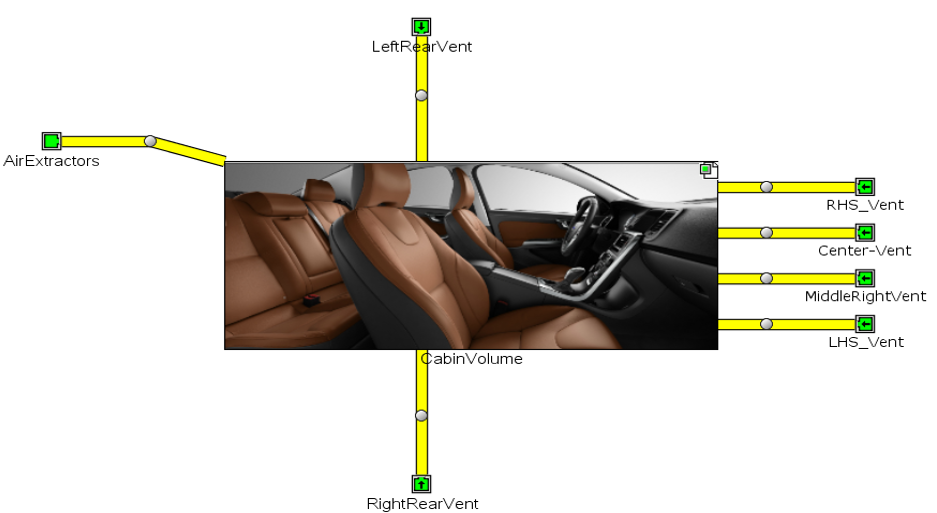 Figure 1
Figure 1This post answers the key question of accuracy and the value of integrating GT-SUITE with TAITherm – exhibiting a validation of the approach and an overview of the methods employed. For the speed reader, the short answer is: integrating GT-SUITE and TAITherm resulted in good agreement with measured values of surface temperature for a sedan undergoing a hot pull-down drive test in a climate-controlled wind tunnel. The long answer is: the rest of this blog, and we invite those interested to continue with us through the details.
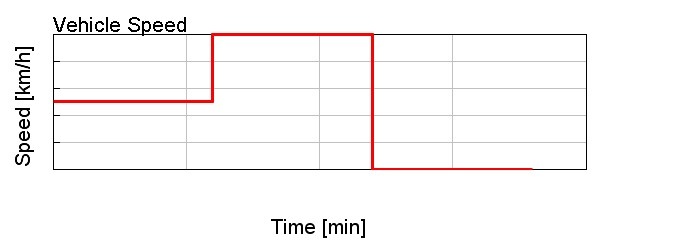 Figure 2
Figure 2To assess vehicle cabin thermal comfort and simulate the response of a typical sedan, ThermoAnalytics and Gamma Technologies were granted access to transient thermocouple and boundary condition data for a hot pull-down of a 2012 Volvo S60 (see Figure 1, photo of an S60 interior). This data set included exterior boundary conditions and internal airflow and temperature measurements. Figure 2 is a plot of vehicle speed vs time, a common approach to hot soak analysis.
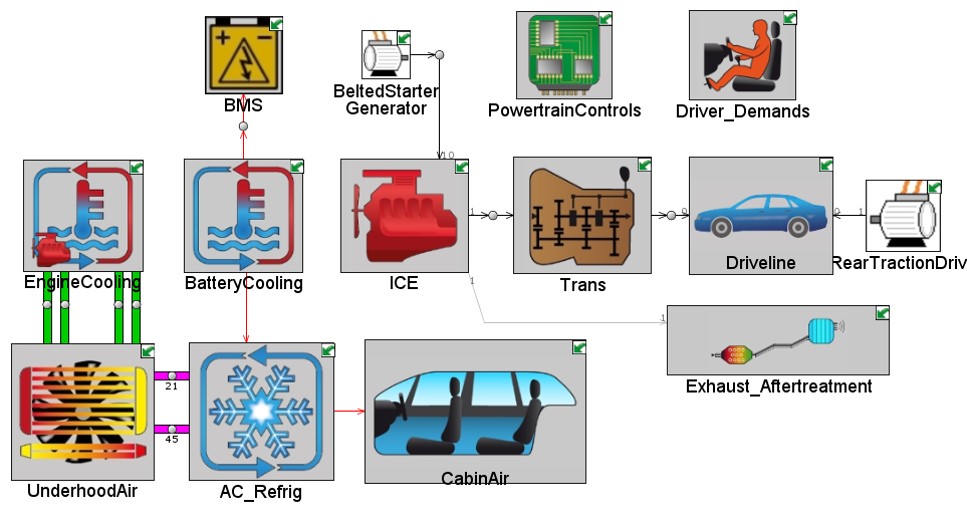 Figure 3
Figure 3The limitation for publication of this test is that no numerical values could be divulged; our plots reflect this fact yet still allow for assessment of method accuracy. A comprehensive analysis was performed and presented at the June 2016 HdT conference in Potsdam, Germany.
A brief summary of the approach is that GT-SUITE automatically generated a coarse cubic grid of the vehicle interior and handled both the 3D flow and interacting systems such as the A/C loop and complex engine models. Figure 3 shows an example GT-SUITE model integrating 1D and 3D analyses in a single simulation of a vehicle.
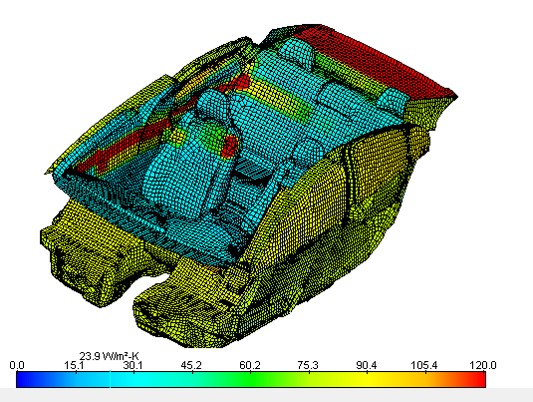 Figure 4
Figure 4TAITherm computes conduction and surface to surface radiant heat transfer between the solid objects, and handles the environmental boundary loads, including solar effects and transparent glass. The solar load in the measured case was a stationary solar lamp, however TAITherm is also capable of modeling more complex moving sun problems. The two codes exchange data at the surface-fluid interface, with convection values in GT-SUITE delivered to TAITherm: a distribution of those values mapped on the interior can be seen in Figure 4.
 Figure 5
Figure 5Note that the passenger side has an extra vent in the model S60, and this asymmetry is captured in the convection distribution as it strikes the side of the passenger front seat near the vehicle's center. A single calibration was made to properly scale the convection coefficients delivered by GT-SUITE. See Figure 5 showing the cubically discretized interior volume and associated TAITherm surface mesh.
 Figure 6
Figure 6The four airflow inlets and release vents are diagrammed in Figure 6. This distribution of flow was imposed by GT-SUITE to compute the internal flow and cabin air temperature distribution. A breath-level cross section of fluid temperatures is shown in Figure 7, demonstrating that a coarse cubic mesh can capture the relevant fluid temperature distribution.
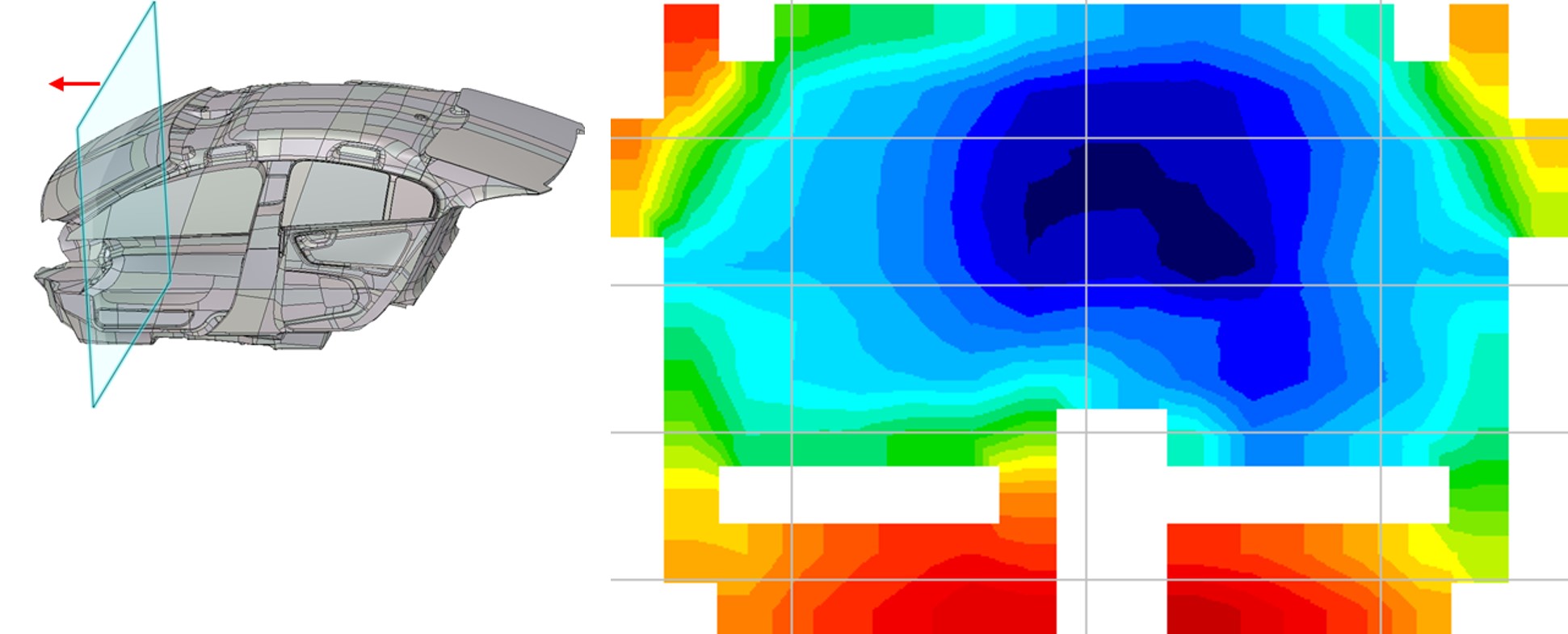 Figure 7
Figure 7In the plots below, the red trace is the measured surface temperature data from the sedan, including the front seats, driver door, windshield and rear foot area. This selection of locations provides a representative "picture" of the distribution over the pull down process.
It should be noted that the precise location of the thermocouple mount points was unknown, so the comparison simulation nodes are a best guess, based on typical industry standards. This uncertainty for the driver's door had a significant impact, so a plot of a temperature near the front of the door and the rear are included from the simulation. These two plots "bound" the measured solution, though neither appears to have been mounted to a surface with the same thermal mass as the measured location.
 Measured surface temperature data from the sedan
Measured surface temperature data from the sedanThose interested in cabin climate comfort analysis would find that interior surface temperatures all follow a characteristic pull-down curve, but the exterior windshield temperature is convection driven through the first two-thirds of the test. After the vehicle speed returns to 0 for the final third, it begins a normal exponential drop.
Because these plots collectively show very good agreement, we conclude that this integration is valuable because of the good accuracy and nearly real-time computation time. Vehicle manufacturers can thus look forward to gaining shorter time-to-market by increasing design iterations earlier in development using the GT-SUITE software with TAITherm.
So what's our next application-specific integration between GT-SUITE and TAITherm? Beyond extending this HVAC system design to include the industry-leading Human Thermal technology, the next application will be underbody transient thermal analysis. Stay tuned to see how this computationally-demanding simulation can be handled as an integrated 1D system simulation coupled with full vehicle geometry, and still be computed faster than ever. If you find this new technology interesting and would like to explore it further with us, please contact us.
This blog was developed in conjunction with Dan Marsh from Gamma Technologies. Dan has worked at GT since the summer of 2010. Dan is a senior engineer and application leader for climate systems simulations within GT-SUITE. His responsibilities in this area include managing development, customer support and trainings. Dan also handles development planning for the main model building graphical application within GT-SUITE.

